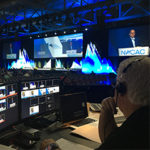A really great place to work has to do a lot of things really well. When Fortune magazine, in conjunction with the Great Place to Work Institute, polls hundreds of thousands of employees about what life at their company is like — for Fortune’s annual “100 Best Companies to Work For” list — there are questions about camaraderie, management, hiring practices, benefits, and much more. But nothing that directly addresses how these companies plan meetings.
We think this is an oversight. Considering how big a role face-to-face meetings play in the professional lives of employees in almost every industry we figured that these Best Companies to Work For must have some aces up their sleeves when it comes to getting their people together – for everything from everyday staff meetings to strategic-planning retreats to large-scale sales conferences.
And we were right. We spoke to meeting planners from five different companies on this year’s Fortune list, asking them what’s special about how they meet.
THEY HAVE FUN WITH IT

When we asked Cindy Scharringhausen, senior vice president of human resources for Houston-based Camden Property Trust, how its meetings have contributed to Camden’s status as a Best Company to Work For, she shot back, “[We have] as many meetings as possible,” then quickly added: “Just kidding.”
Although it might seem obvious, having fun at in-house meetings and events is very important. “Pretty much our philosophy is inclusiveness and informality and fun,” said Scharringhausen. “There’s always camaraderie or a spirit of transparency or sharing at all of our meetings and events.”

Camden’s annual two-day management conference, held each May at a different hotel or resort, draws 400 to 420 attendees – not only those employees who oversee a certain territory or other employees, but also key salespeople, award winners, support teams, and guests. “We probably have more people attend meetings rather than less,” Scharringhausen said, “so that everyone gets the information.” Given the diverse array of attendees, Camden meeting planners take care to schedule learning opportunities that will be interesting to every facet of the company — as well as chances for people to connect, build relationships, and have fun. “As much as we do invest in it, we tend to be value-minded,” Scharringhausen said. “We are not hiring the top rock-star band for $200,000. Rather, we are hiring just the right amount of external resources that fit the message we’re trying to deliver.”
One way that Camden has fun on a budget is with Skit Night, a program on the first night of the management conference for which the company taps three of its regional teams and one corporate team to “plan, practice, and develop a humorous skit,” according to Margaret Plummer, Camden’s vice president of employee development. “Before the meeting, there is a tremendous amount of team-building that goes on,” as the groups work together to come up with their opening-night routines. And beyond the team-building benefits, Plummer said, “It’s hysterical to watch people we’ve known for years get up and perform.”
In addition to Skit Night, Camden fields its own house band (as well as a “local, reasonably priced band”) for Dance Night, which also includes fun stuff like bobble-head mementos, photo booths, and – this year – an air-guitar contest, hosted by an employee in the conference’s lobby area. Why go to all this trouble for a management conference? For a simple reason, according to Scharringhausen: “We want people to look forward to it.”
THEY LISTEN TO THEIR PEOPLE

Whether it’s something relatively minor like food and drink or something more fundamental, like what a meeting’s educational or business focus is, Best Companies to Work For are also good about getting their employees involved in the planning process. “We spend a lot of time on pre-event communications,” said Don Jones, vice president of sales for the Americas at Four Seasons Hotels and Resorts, where he’s a 25-year veteran. That means “really understanding what people’s needs are, and how this meeting is going to serve those needs.”
One of the bigger meetings for which this gets practiced is Four Seasons’ biannual global marketing conference, held most recently this past May 13-16 at the brand-new Four Seasons Hotel Toronto, in the hotel company’s headquarters city. Three-hundred fifty people attended the meeting, including directors of marketing for each of Four Seasons’ 93 properties worldwide, as well as general managers, directors of revenue, public-relations and agency people, and the company’s global sales organization.

For this year’s conference, Four Seasons sent out a pre-event survey “with fairly open-ended questions,” Jones said. “As a collector of data, that makes it difficult. But we wanted to make sure we were really hearing from everyone.” When the surveys came back, the responses to those open-ended questions “absolutely drove the content that we were delivering,” Jones said.
The company is currently on the hunt for a new CEO, and many questions emerged about that change in leadership and how it would affect Four Seasons’ overall direction. “While this was a marketing conference, we realized we had to step away from marketing and make sure that our fellow associates were comfortable with our leadership and direction and growth strategy,” Jones said. “We had to put people at ease that that culture was going to stay intact.”
Of course, it’s not always big-picture stuff that has employees anxious – sometimes it’s more quotidian matters like what’s for breakfast, as one of our other Best Companies to Work For discovered a few years ago. “The No. 1 concern at our 2010 conference was that there wasn’t bacon at breakfast,” Camden’s Scharringhausen said proudly. “If every year the only concern is bacon, for $150 I can fix bacon any time of the week.”
That might sound like small potatoes (or hash browns), but employees want to know they’re being listened to. So Camden made sure the next year that there was plenty of pork on the menu, even going so far as to make an inside joke of it by working with the host hotel to get bacon involved in every meal — even dessert.
THEIR MEETINGS MATCH THEIR CULTURE

Robert W. Baird & Co. is an employee-owned wealth-management, capital-markets, asset-management, and private-equity firm based in Milwaukee. Ann Woelfel, CMP, is the company’s vice president and manager of corporate events. When asked whether Baird has an internal “philosophy of meetings,” Woelfel said it doesn’t, because it doesn’t need one — all it needs is its own culture. ‘We always follow the main company culture guidelines, and they flow into all the work that we do.’ “We always follow the main company culture guidelines,” Woelfel said, “and they flow into all the work that we do.”

First and foremost, Baird is looking for seamless and flawless execution of its meetings, which begins with understanding the core objectives of the program — and that in turn means working with internal stakeholders to determine ahead of time what those might be. From that point forward, it’s all about getting the details right, to create the ideal Baird experience. “That means thinking about creating the essence of our culture in every step of the process,” Woelfel said, “from the first pieces of correspondence until [the attendees] are back on the plane on the way home.”
Baird’s annual meeting takes place in Milwaukee, alternating years as its own freestanding, 700-attendee event that’s webcast live to all of Baird’s U.S. branch locations and as a co-location with a private wealth-management symposium. To get company culture just right — with its emphasis on transparency, shared destiny, and celebration — Woelfel and her meetings team work closely with a variety of internal departments, the marketing group chief among them, “to create concepts that embody the Baird story.” Each year the company’s annual report has a theme that also is carried over to the annual meeting. This year’s theme is “Staying True” — and, Woelfel noted, “We want them to feel that theme throughout the conference.”
Because Baird has been identified as a Best Company to Work For, it may come as no surprise that making its employees feel valued is key. “We always call ourselves the Baird family,” Woelfel said, “and treating everyone in that way — especially at our annual meeting and at recurring events, which are celebrations of our culture and our successes — is very important.”
THEY INVOLVE THEIR BIG NAMES

Kati Quigley, CMP, is the senior director of worldwide partner group marketing for one of the biggest companies in the world: Microsoft. (She’s also a former chair of the PCMA Board of Directors.) And while there’s a huge variance in the substance and style of the software giant’s many meetings and events, Quigley said, the overall message from HQ is that they should be conceived of primarily as vehicles for marketing, whether they’re internal or external programs.

One thing that is different between internal and external meetings is social media. Obviously at public-facing events, Microsoft encourages attendees and employees to tweet and use other social media to their heart’s content. But for internal meetings, while the company still wants people to be able to communicate using social media, it needs to keep a lid on sensitive information. Microsoft does that via an app called Yammer, which essentially functions like a private Twitter.
Beyond that, given its size and scope, the house that Bill Gates built has a challenge that is unique to companies of its size: It’s much easier for rank-and-file employees to get lost in the shuffle, and to lose sight of the company’s mission. To counteract that drift, one key function of any Microsoft meeting, Quigley said, is motivation – “getting everybody rallied around the company direction and what the ‘go-do’s’ are.” Another major focus is product info – “what’s new and what’s coming.”
At high-profile gatherings, including the 10,000-attendee company meeting, held each September, this is accomplished by putting Microsoft’s “big names” front and center.
“You get to hear from our executives and our innovators, and you realize how many smart people work at this company,” said Quigley. “It’s beyond what you would imagine, so that’s inspiring.” For smaller occasions, such as monthly executive Q&A meetings that are held in-person for a couple hundred people (and webcast across the world), the same principle applies, with high-level executives communicating directly to employees about what’s new and exciting at Microsoft.
The executive meetings cover many different topics – the launch of the new Surface tablet computer, for example, or the chief marketing officer discussing what’s on the horizon for advertising -but one thing they have in common is that there is always “quite a bit of time” devoted to a question-and-answer session with top executives.
This serves to collapse or flatten the structure of a big company like Microsoft, allowing people like CEO Steve Ballmer – who often participates in the executive Q&A – to learn and receive feedback from his tens of thousands of employees, and for those same employees to feel that they have a direct connection to management. Quigley said: “The frequent employee sessions show how vested the executives are in being engaged and connected with the whole company.”
THEY SPREAD THEIR MESSAGE

Although there are some Best Companies to Work For that jealously guard the secrets that make them great, online shoe retailer Zappos is not one of them. Instead, founder and CEO Tony Hsieh wrote a combination memoir and management tome called Delivering Happiness, which shares with the world his company’s philosophical foundation — and tells other enterprises how they, too, can be like Zappos.
This share-and-share-alike impulse carries over to three-day “boot camps” that are planned by Emaile Hill, Zappos’ events samurai (her actual title), which other companies travel from all over the world to Zappos’ headquarters in Las Vegas to attend.
The boot camps happen alongside Zappos’ quarterly all-hands meetings, and their focus is to teach other companies about the shoe merchant’s business, and how Zappos made it to where it is today, in terms of its successes in both business and company culture.
“The biggest piece of it is just the ‘delivering happiness’ aspect of it, and us wanting to change the world in that regard,” Hill said. “We want to have happier people, especially in the workplace, because you spend so much time there.”
Zappos has been holding its boot camps for nearly four years now, and has had as many as 38 people from 10 different companies take part at any one time. Attendees get two days in the classroom, hearing from various Zappos departments, and on day three they participate in the 1,500-employee all-hands meeting.
“They are totally infused in our culture for three days,” Hill said. Indeed, culture is the boot camp’s main focus, from the importance of Zappos’ culture to its mission and business, to how that culture has had such a positive impact on the company
In a significant validation for this strategy, several companies whose employees attended a boot camp later went on to be named to a local or industry-specific Best Company to Work For list. “Any time we get that kind of feedback is definitely a proud moment for the organization,” Hill said, “as well as for us to know that we’ve been a part of their journey to help get them there.”



